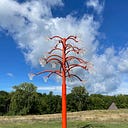It’s Holocaust Remembrance Day: A Time to Reflect on Our Dark Past to Chart a Brighter Future
An Idiosyncratic Guide to Essential Memorials & Museums
It’s Holocaust Remembrance Day. It used to be clear what that meant, before Holocaust denialism took root, before younger generations lost touch with that historical event and started doubting it, before misinformation and deep fakes started twisting reality. Now, as anti-Semitism surges again across the world, as disputes rage about who is able to claim the mantle of genocide, and as fewer Holocaust survivors are able to bear witness to those unspeakable atrocities, those of us who are alive only because our ancestors evaded that genocide, who are alive despite centuries of persecution and violence, must speak up.
So today I honor all those who perished, survived and resisted, all those who helped, all those who took risks to find new homes where they might find safety and acceptance.
Today I honor the soldiers and partisans who died and suffered unspeakable physical and emotional scars fighting Hitler and Nazism, including my dear father, who fought under Patton during World War II and captured the atrocities he witnessed in pictures (since donated to the US Holocaust Memorial Museum), pictures seared into my mind from growing up with them.
Today I honor the people and places around the world who keep these Holocaust memories alive, as well as those of other horrors perpetrated against people because of who they are and what they believe.
Museums of conscience and memorials to tragedy are critical reminders of what humans are capable of — the horrible, but also the good. They shine a light on the steep price of dehumanization and othering. Their voice is critical — museums still hold a place of special trust in our society, a bulwark against misinformation and historical revisionism.
As fascistic movements and ethnic strife gain momentum and threaten renewed cycles of violence across the globe, it’s essential that we teach this history so it doesn’t happen again.
So I urge all of us, and especially parents and teachers, not to shield children from this history but to expose them to it so they never forget.
An avid museum goer, I’d like to share a few of the museums, memorials and exhibits that have deeply affected me and my family:
- The Sachsenhausen concentration camp outside Berlin is the “model camp” that explains the methodical logic behind the Nazi genocide.
- The House of the Wannsee Conference outside Berlin is where the Nazi Final Solution was hatched.
- The Mauthausen concentration camp in Austria (that my father helped liberate), which we visited on a chillingly cold day. Knowing that my father was there and what he must have seen was deeply moving. I only wish I could have seen it and talked to him about it before he died.
- The Memorial to the Murdered Jews of Europe in Berlin. Walking through that immense array of stone blocks gave a sense of the enormity of loss as a result of the Holocaust.
- The Memory Center and Martyr Village of Oradour Sur Glane, a preserved small village in France that was incinerated by the Nazis during World War II. De Gaulle made sure it was preserved and the story of the atrocities were told.
- The Legacy Museum and National Memorial for Peace and Justice in Montgomery, Alabama vividly trace and document the history of slavery, Jim Crow, and its enduring legacy today. These sites are nothing short of transformative. We have been twice already and will return to visit the new sculpture park.
- The Japanese American National Museum in Los Angeles, where we saw a deeply troubling exhibit on Japanese internment in the US during World War II. The way the US treated the Japanese is something we should all be profoundly ashamed of. I’ve written about how that internment presaged much of the overreach against Arabs and Muslims following the 9/11 attacks.
- The Tuol Sleng Genocide Museum and the Choeung Ek Killing Field in Phnom Penh, Cambodia. More than a million Cambodians were slaughtered by the Khmer Rouge.
- And Phoenix’s Heard Museum has an indelible exhibit about the campaign of forced assimilation of Native American youth in US government-operated boarding schools.
Obviously, there are so many more important sites like these all over the world and many ways to bear witness to these and other grim histories. I want to spend more time at Japanese internment sites across the US, like Manzanar, and revisit Yad Vashem in Israel. And before I travel, I make sure to look through the incredible roster of sites that form the International Coalition of Sites of Conscience network to identify meaningful places to visit.
Of course, if you don’t have much time or don’t want to travel, please start by seeing Origin, Ava Duvernay’s adaptation of Isabel Wilkerson’s brilliant book, Caste. Those two hours will help put all the pieces of this tragic puzzle together.
